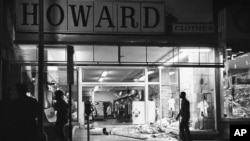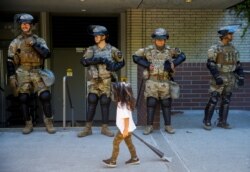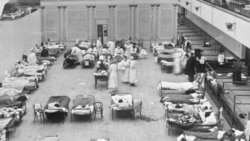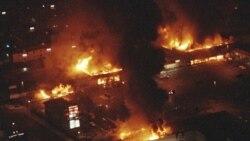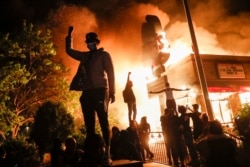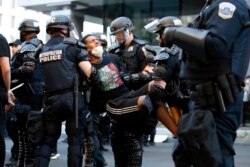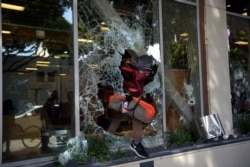The streets were on fire as National Guard troops moved into cities across the United States. The cries were full of anger and sadness. “We’re sick of it!,” protesters shouted.
There was talk of “radical agitators.” Reports of violence and numbers of arrests were rising across the country. The president and his top aides made martial statements about law and order. On television, news and images of unrest seemed to play almost continuously.
The voice from the U.S. space agency’s mission control center was cool and calm as a rocket flew into the sky and toward space.
It was the late 1960s. It is also right now.
For Americans over the age of 60, it is impossible to ignore the similarities between the past few days and unsettling times in the 1960s, especially 1968. It was a year marked by assassinations and social unrest.
And there are reasons to believe that 2020 may become more famous than 1968 as one of the most powerful social and political points in U.S history.
From a president standing trial to the coronavirus crisis, from massive unemployment to the death of George Floyd last week, all of the similarities are there.
Thurston Clarke wrote the book “The Last Campaign.” It explores the 1968 presidential campaign of Senator Robert Kennedy and his assassination on June 5 of that year. He died the following day.
Clarke compares 2020 to an “anti-hit parade,” with the greatest disasters of the past 100 years or more “all hitting us at once.”
During the first five months of this year, history’s ghosts from America’s past have returned:
— From 1918, when the first wave of a deadly influenza pandemic came, then slowed, and then grew into a more powerful second wave.
— From 1930, when an economic crash showed its longer-term effects on American citizens in the form of a Great Depression.
— From 1974, and the break-down in government that came before Richard Nixon resigned as president. That returned in January and February of 2020 with the impeachment trial of President Donald Trump.
— From 1992, and its images of Los Angeles burning, after a court dismissed charges against four police officers in the beating of Rodney King.
Maybe the most uneasy period to compare 2020 to is the one no one really wants to talk about: 1860, right before what would become the Civil War.
Slavery, America’s greatest historical shame, was the turning point then. Today, it is police violence against black people, which historically is linked to slavery. Then, as now, there was deep economic inequity and a debate between individual rights and the common good. There are different, sometimes competing ideas of American life. There were different sets of facts and ever more unclear ideas of truth.
John Baick is a U.S. historian at Western New England University in Massachusetts. He said what is common among all these things in our history is “a lack of agreement of what reality is — a lack of agreement about facts, about causes.”
Baick added, “When we can’t agree on basic truth, we reach our greatest periods of divide.”
But now, we live in a time of social media, which is overloaded with images and messages meant to persuade and influence. And even what can appear on social media is a subject of national dispute, thanks in part to the president.
Problems are sometimes addressed, sometimes ignored, or never truly solved. That is what has the deepest effect on Frederick Gooding Junior, who teaches about race.
He sees commonalities between today and the years immediately after the Civil War. At that time, African Americans were faced with the realities of life after slavery.
He said newly freed African Americans “walk[ed] the streets in psychological terror.”
Gooding is an associate professor of African American studies at Texas Christian University.
He told The Associated Press there is nothing new about “the structure of our society and the way it behaves.”
Things are starting to repeat, he said. There is anger. It grows. There is a new understanding. Then things are put in place and then the situation repeats itself.
But right here, right now, 1968 seems the most similar comparison of all.
Then, it was politics and economics and race — especially the killing of civil rights leader Dr. Martin Luther King Jr. The backdrop was the Vietnam War, which killed countless Americans.
Now, it is politics and economics and race — especially the death of George Floyd — with the backdrop of the pandemic, which has killed over 100,000 Americans.
There are clear differences, however. The power structures have changed and are somewhat more inclusive, but nowhere near where many hoped they would be.
One example is from the city of Chicago. In 1968, Chicago Mayor Richard J. Daley denounced people protesting at the Democratic Party’s National Convention. He ordered National Guard troops to stop protesters from gathering near convention delegates and presidential candidates. Today, Chicago’s mayor is Lori Lightfoot, an African American woman and the first openly gay person to hold the office.
Maybe the biggest difference is that, in 2020, protesters in one place can see and hear what is happening in other cities through social media.
Some questions, then:
Is this period a singular point of time in American life? And will people gathering and colliding aggressively lead to things we have yet to consider?
It is still hard to say.
I’m Alice Bryant.
The Associated Press reported this story. Alice Bryant adapted it for VOA Learning English. George Grow was the editor.
_______________________________________________________________
Words in This Story
radical agitator - n. a person who stirs up people in order to upset the status quo and further a political, social, or other cause:
martial - adj. describing the control of an area by military forces rather than by the police
assassination - n. the killing of someone, such as a famous or important person, usually for political reasons
ghost - n. the soul of a dead person thought of as living in an unseen world or as appearing to living people
pandemic - n. n occurrence in which a disease spreads very quickly and affects a large number of people over a wide area or throughout the world
shame - n. a feeling of guilt, regret, or sadness that you have because you know you have done something wrong
address - v. to deal with a matter, issue or problem
backdrop - n. the setting or conditions within which something happens
gay - adj. sexually attracted to someone who is the same sex



